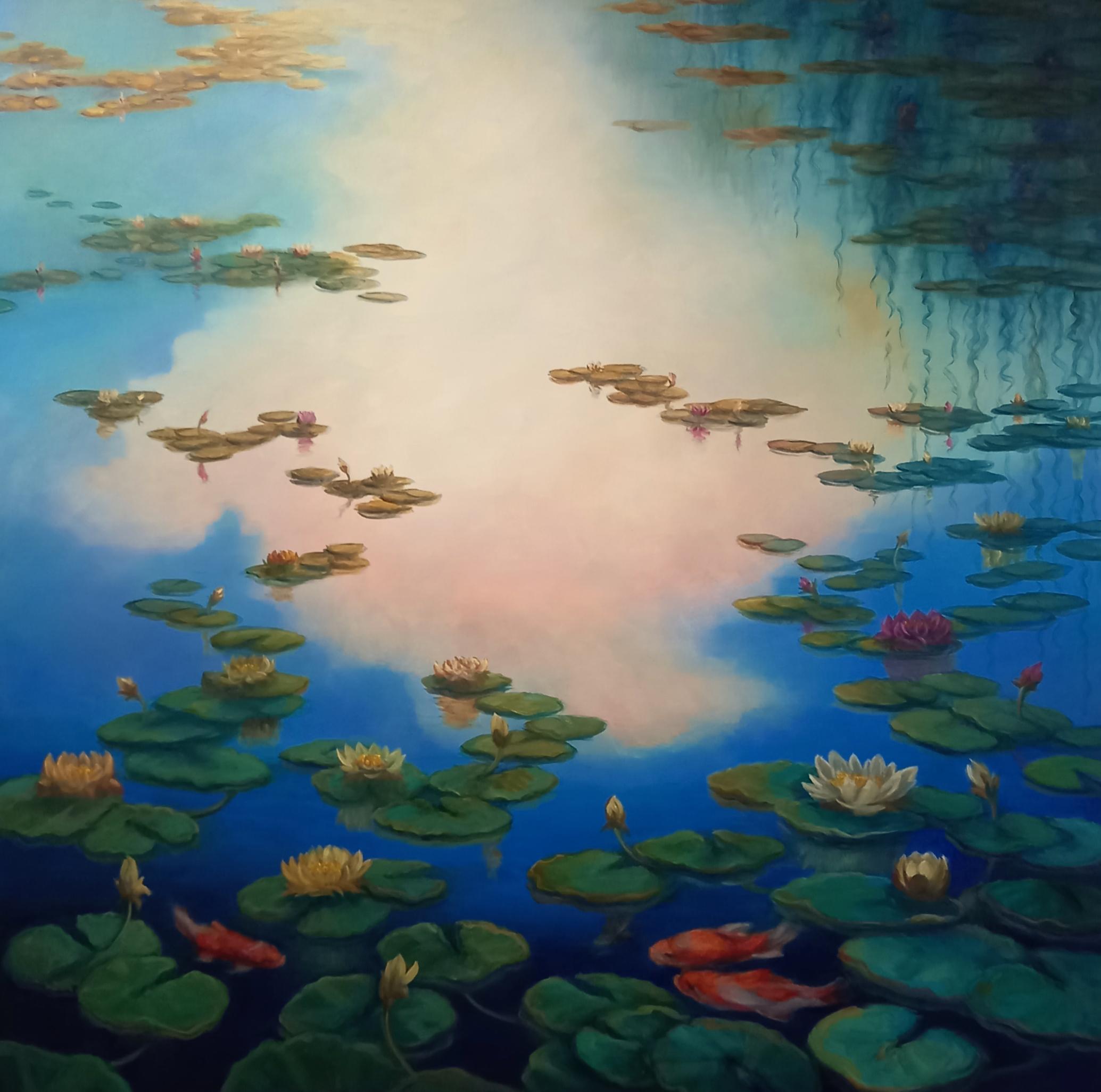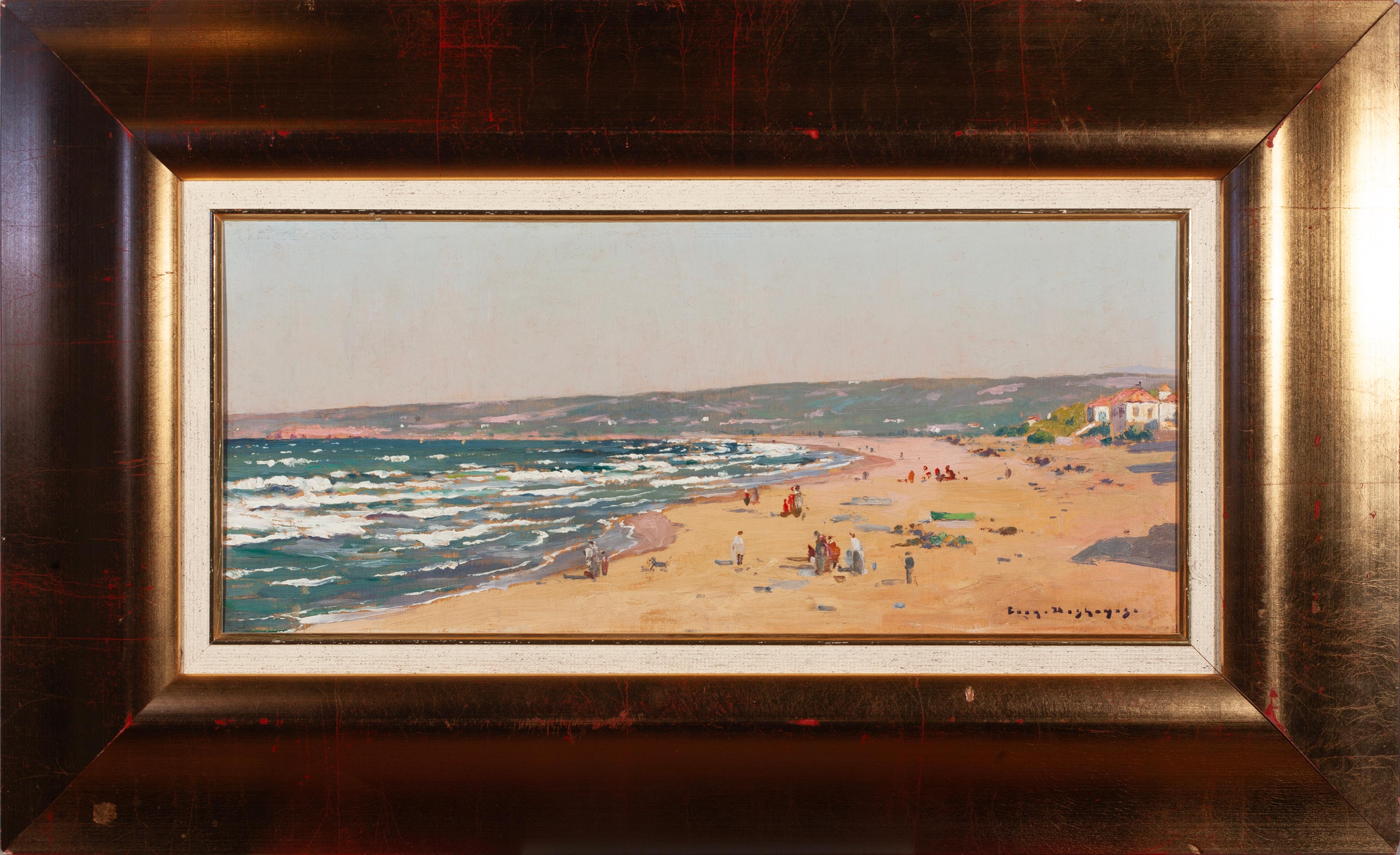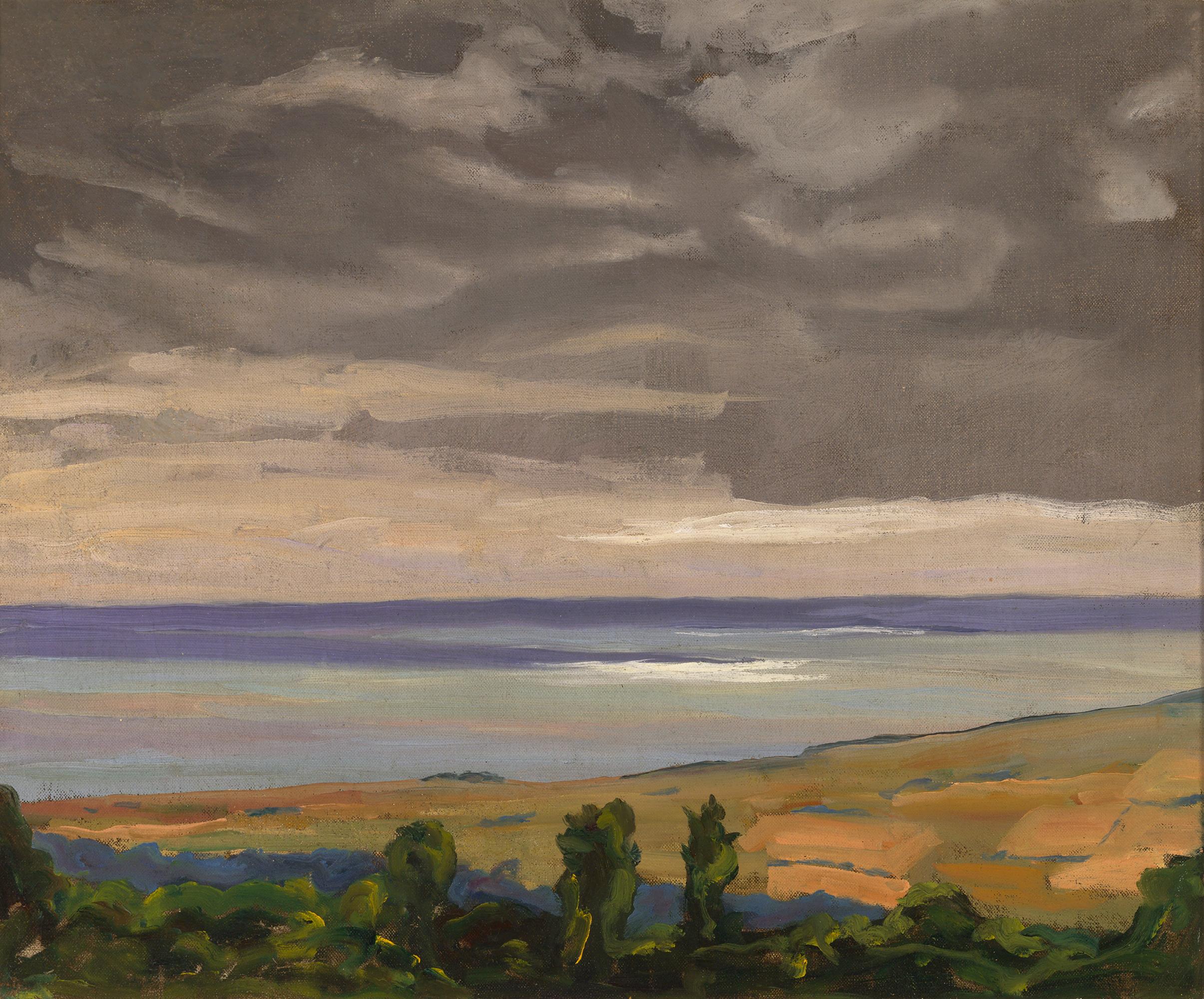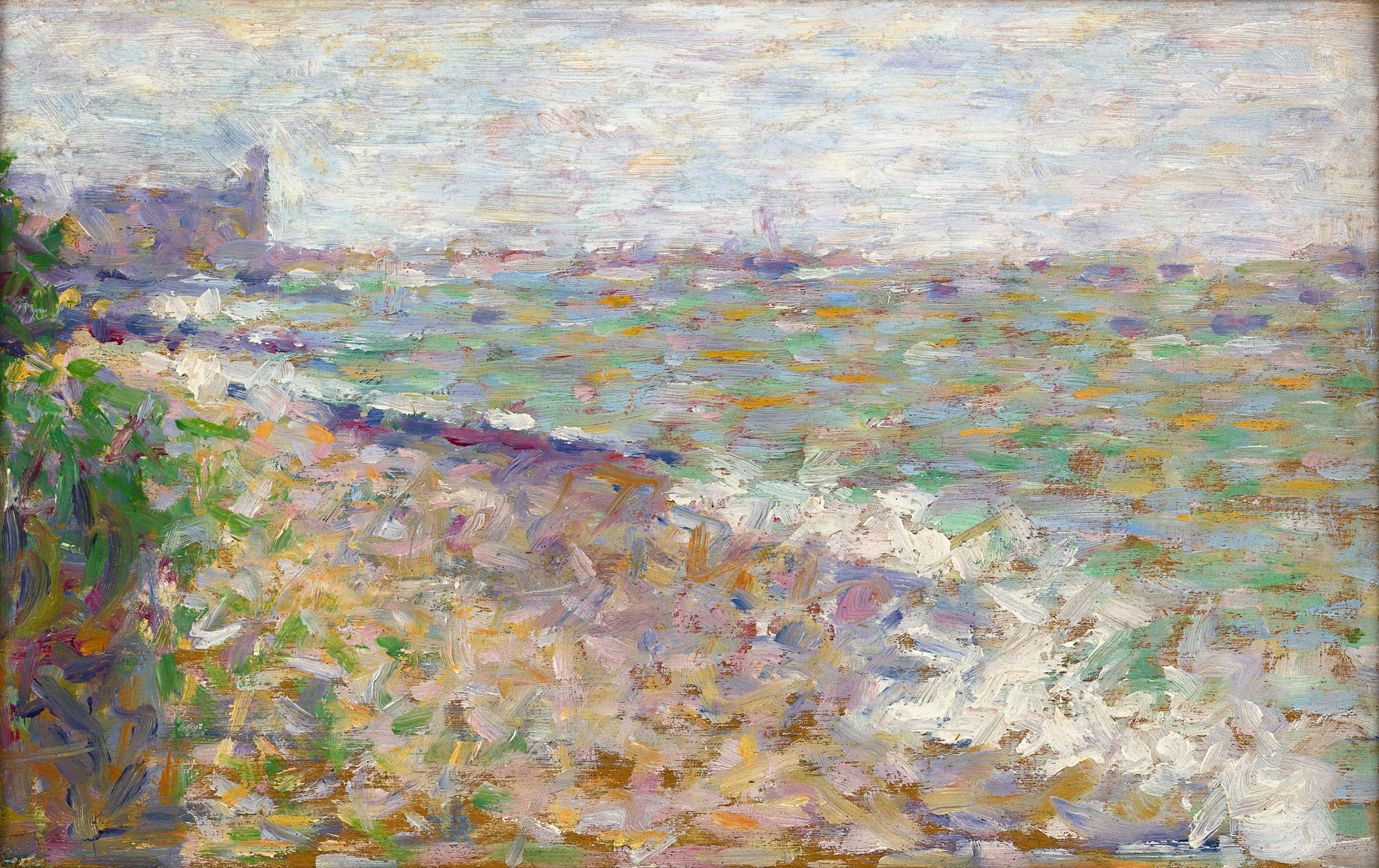Items Similar to California Landscape
Want more images or videos?
Request additional images or videos from the seller
1 of 12
Virginia (Ginger) ShaverCalifornia Landscapec.1990
c.1990
About the Item
This artwork "California Landscape" c. 1990 is an oil painting on canvas by American artist Virginia (Ginger) Shaver, 1939-2020. It is signed on the back in pencil by the artist, also inscribed "V. Shaver 1939-2020" in black marker. The canvas size is 30 x 40 inches. It is in excellent condition.
About the artist:
Raised in Black River Falls, WI, Ginger earned her degree in nursing from the University of Minnesota Twin Cities, her Masters in Art Therapy from Mount Mary College, and her PhD in Art Therapy from Union Institute & University. This post impressionist artist gained recognition for her colored landscape of the northern California country side, especially the Napa/Sonoma area.
- Creator:Virginia (Ginger) Shaver (1939 - 2020, American)
- Creation Year:c.1990
- Dimensions:Height: 30 in (76.2 cm)Width: 40 in (101.6 cm)Depth: 0.75 in (1.91 cm)
- Medium:
- Movement & Style:
- Period:
- Condition:
- Gallery Location:San Francisco, CA
- Reference Number:
About the Seller
5.0
Platinum Seller
These expertly vetted sellers are 1stDibs' most experienced sellers and are rated highest by our customers.
Established in 1999
1stDibs seller since 2017
684 sales on 1stDibs
Typical response time: 1 hour
- ShippingRetrieving quote...Ships From: San Francisco, CA
- Return PolicyA return for this item may be initiated within 7 days of delivery.
More From This SellerView All
- Landscapes with sea. Two paintings on hardboard, one is signed.By Lucien MainssieuxLocated in San Francisco, CAThese paintings "Landscape" are 2 oils on hardboard by noted French fauvist artist Lucien Mainssieux 1885-1958. One of the two is signed at the lower...Category
Mid-20th Century Fauvist Landscape Paintings
MaterialsOil
- CityscapeLocated in San Francisco, CAThis artwork "Cityscape" c.1990 is an oil painting on canvas by Italian artist Giovanni Sangalli, b.1930. It is signed at the lower left corner by the artist. The canvas size is 15.5...Category
Late 20th Century Post-Impressionist Landscape Paintings
MaterialsOil
- Little bayLocated in San Francisco, CAThis artwork "Little Bay" 2012 in an oil painting on wood panel by Uruguayan artist Alejandro Rubio, b.1963. It is signed at the lower left corner by t...Category
21st Century and Contemporary Post-Impressionist Landscape Paintings
MaterialsOil
- California LandscapeLocated in San Francisco, CAThis artwork "California Landscape" in an oil painting on paper by Uruguayan artist Alejandro Rubio, b.1963. It is signed at the lower right corner by ...Category
Late 20th Century Post-Impressionist Landscape Paintings
MaterialsOil
- Medieval CityBy Alois LecoqueLocated in San Francisco, CAThis artwork titled "Medieval City" c.1960 is an oil painting on canvas by Czech/American artist Alois Lecoque 1891-1981 It is signed at the lower right corner by the artist. The canvas size is 24 x 32 inches, framed is 30.35 x 38.25 inches. Framed in a wooden gold frame, with gold color bevel and fabric liner. It is in excellent condition. This artwork is a perfect example of the work of Alois Lecoque whom continued through the end of the 20 Century, the style of the famous French impressionists like Manet, Renoir, Cezanne and Monet. About the artist. Alois Lecoque was born in Prague in 1891 as Alois Kahout. His father, an engineer specializing in the regulation of rivers and hydraulic stations, wanted him to follow in his footsteps but Alois wanted to be an artist and his father wisely assented. After six years of formal study at Prague's Real Schule, he went to Zagreb to study at the Art Institute under Professor Crncic. There he mastered the technique of capturing scenic objects in effervescent color. Alois Kahout was such an outstanding student who applied himself assiduously that he left the institute with high honors. So pleased was his father that he agreed to allow his son the dream for opportunity to go to Paris where the art world was in such an excited ferment. In Paris he attended the Academie Julian studying under professors Baschet, Emile Bernard and others who were highly respected by the Post Impressionist school of painting. Kahout now became Lecoque - the French name for Rooster, which had the same meaning in the Czech language. Renoir, the great master took a liking to the young artist and taught him many of his secrets; predicting that his drive and originality would one day make him famous. Establishing his own studio in "La Ruche des Artistes" located in the famed Vauguirard quarter, he met and became friends with many artists whose works have since achieved world acclaim, including the sculptor Zadkine, Miossi Kogan, Modigliani, Soutine and many others. In 1913, his works were exhibited at the Anglo German Exhibition at the Crystal Palace in London. In 1914, Lecoque returned to Prague where he was highly honored by winning the first prize of Frs.3,000 in gold by Architect Turek. The press raved with acclaim and Lecoque basked in the glory of local celebrity. His paintings were in great demand and as befits a successful painter he moved into an entire floor of the Coloredo Mansfeld Palace. Here he played well the role of social lion and entertained lavishly like a Seigneur. Important personages found it fashionable to be linked with his name. But World War I exploded and so did Lecoque's high style of living. He spent the war years in Prague because of a medical exemption, and the Austrian government realized that it was better to keep such a famous painter home than to send him to the front. Meanwhile Lecoque endured an unhappy marriage and left Prague in 1920 to journey to Algiers at the invitation of his friend Dinet in Bou - Sada, deep in the heart of the Sahara desert. He remained for two years in different places of North Africa and then his restless soul compeled him to return to Paris, which he loved and missed intensely. There - at the Rue Jacob - Lecoque concentrated on scenes of the Siene River, the Cathedral of Notre Dame and the interesting bridges. He worked feverishly, and in two years he had enough paintings for an exhibit at the Andree Galarie where his works were avidly snapped up by collectors. Restless again, he went to the coast of Brittany, Brignogan, where he painted with such fury that he was able to go back to Paris with enough works for a second showing that brought such favorable reviews from the critics and such financial rewards that his friends urged him to remain in Paris and reap his due there. However, Emile Bernard longed for his company and beckoned him to Venice. On the Canal Rio del Piombo he occupied a studio in one of the palaces and here he settled down to serious work. Evenings were spent in the company of Emile Bernard, the Russian painter Resrodni and the Italian poet, Luigi Gentina. They debated politics, art, women, and not necessarily in that order. One of his crowning achievements was capturing vividly a few gondolas lazily moving over the surface of the Canale Grande, while white snow fell over the Bysantine-like rooftops. This and other paintings were accepted for the exhibit in the Biennale of Venice in 1926 and again in 1928. But as much as he enjoyed Venice, Lecoque had to depart hastily, due to his innocent involvement in a plot to assassinate Benito Mussolini. Back to Prague he went in 1925 where he settled down to enjoy 13 of the most exciting years of his life. Here in his beloved home city, Lecoque's popularity rose immensely. Overnight his paintings increased in value and many of his works were purchased by the government. Meanwhile he exhibited in Prague, Ostrava and Bratislava and often traveled to Paris to meet his friends, George Kars, Kupka, Utrillo and others. He also took time to remarry and find happiness for a while with his second wife. The clouds of War descended again on Europe and because of his bold and controversial political philosophies Lecoque again was forced to flee. Hunted like an animal by the Nazis, he escaped to free Yugoslavia, where he boarded his yacht, "Angela," sailing from one picturesque harbor to another down the Dalmatian coast and the Greek islands. Then both Yugoslavia and Greece were occupied by the Nazis and fascist armies, Lecoque saved his life in Dubrovnik, in the Italian zone. However after the capitulation of the Italian army in Dalmatia, Lecoque was captured by the Germans and sent to Sarajevo where he spent many months in prison. After a trial the military confined him to Dubrovnik. But, before the end of the war he was again arrested by the Gestapo and together with 43 partisans, imprisoned. One morning, when the Gestapo came to execute Lecoque and his friend Spitzer the director of Police, a Croate who liked Lecoque's paintings very much, surrendered only Spitzer to the Germans. That same morning, one of the Partisan women came to bring Lecoque food. Under her shawl she was hiding a machine gun and a large rusted can with some cooked vegetables for him. When Lecoque went to the cell with all the forty three Partisans he noticed that inside the can were three hand grenades. As he did not know how to handle the grenades he learned that his companions had also received various weapons and in this way he was able to exchange the grenades for a Mauser pistol. Then Lecoque called for help and the guard came. When he opened the door Lecoque forced him inside, pressing his gun to the guard's chest, he ordered him to call the other guard. Lecoque promised him he would live providing he followed Lecoque's orders explicitly. They immediately handed over their guns as well as the entire prison arsenal, which Lecoque distributed amongst his fellow partisans. Then, well armed, they all escaped to a medieval tower where they waited until all the Germans had left the city. Dubrovnik, was already occupied by partisans, and they were more than happy to see Lecoque and his fellows alive. They had feared for their lives. Thus with Guile, audacity, genius and multi-language as his arsenal, Lecoque managed to keep his neck intact while his poetic elegance expressed itself in the innumerable canvasses he managed to paint. Finally in the Fall of 1944, the Partisan's whom he had aided in their battled against the Germans, spirited him aboard a Naval vessel in the harbor of Split. It took him to the harbor of Bari in Southern Italy, now in the hands of the Allies. From there an American truck convoy took him to Rome where he was joyously received by the Czechoslovakian Legation. From 1945 to 1951 Lecoque's colorful career as an artist gained new luster and his personal life was enriched by new challenges and opportunities. Rome, Milan, Florence, and Capri now became sources of inspiration for his prolific paint brush and his unique canvases of scenes in those famous cities won him acclaim in numerous exhibits. His keen and perceptive eye, said one critic, "had revealed the splendor of the Italian cities to the Italians." Two of his books were published there but another art form beckoned his versatile talents. His commanding presence and flair for dramatic expression caught the eye of the famed movie director, Carmen Galloni, and he won a role in the motion picture Avanti a lui tremava tuta Roma. His role was that of General Melzer, in charge of the Nazi occupation of Rome. Ironic indeed for the man who strenuously fought the Nazis. The great Italian actress, Anna Magnani, who starred in the film, profusely commended his performance and they became good friends. The picture was highly successful at the box office and brought Lecoque new friends and funds that enabled him to live in a spacious villa on the enchanting Isles of Capri. He settled down there for a while to paint and host elaborate parties. With a studio in Rome, a villa in Capri, once again Lecoque played well his favorite role - that of the Grand Seigneur. Now he could move to the intellectual circles to which he was quite at ease with. Among his friends were Enrico Prampolini, Giorgio de Chirico, Mario Mafai, Josef Jarema, Guttuso Renato and Monachesi Sante. In 1945 he exhibited at the Galleria San Marco in Rome and in 1946 at the Galleria Salvetti in Milano. In 1948 new honors cascaded upon him for his stunning exhibit at the Al Blu de Prussia in Naples and at the Studio de Guillio Parisio. His last exhibit in Italy was held at the elegant Galleria Nazionale de Arte Moderna in Rome, which drew capacity crowds. The sunny skies of Italy, the warmth and animation of the Italians in all walks of life and the sumptuous living made Lecoque's existence there quite endurable - for a while. But the Gods of Adversity had other plans for Lecoque. A hard core of Fascist carry-overs attained some influence in the shaky Italian Government, and Lecoque's alleged part in the attempted assassination plot against Mussolini was not forgotten. A move was made to deport him, and he was sent to the Campo de Capua, a displaced persons camp. He could not go back to Prague which was clamped under the despotic rule of the hated Communists, who were anathema to everything he believed in and fought for. All of the property that he had in Prague was lost. Because of his age, which made immigration impossible to every country he attempted to enter, even his beloved France, he became a man without a country. After many heartbreaking and humiliating experiences in Switzerland, Sweden, and France, he was finally granted permission to enter the United States. But more heartbreak awaited him in America. When he arrived in Chicago during a cruel harsh winter, at age 60, with five dollars in his pocket, he found that the job his sponsor had promised him was just a promise. The promise of full freedom was now ironically fraught with the promise of starvation and despair. But Lecoque's indomitable spirit again prevailed. Soon, with the help of the Czech community and especially Roderick A. Gorman, who became his friend and biographer, Lecoque began painting and exhibiting again. Subsequently, he went to California, and after several successful years in Laguna Beach, he settled in Los Angeles where he maintained an art gallery and frequently sponsored exhibits for other artists striving for recognition. In 1960 he gained one of the greatest treasures of his life - his American citizenship and thus his freedom to roam the world and exhibit his work in the countries of his choice. Paris - which once refused him - welcomed him with open arms when he returned to exhibit in 1961 at the Gallerie Benezit and in 1962 at the Galerie Mercel Bernheim. Again in 1963 he exhibited at the Palais Royal Galerie in Paris and sold one of his paintings to Sir James Farmer Norton, who invited him to visit England. During his visit with Sir James he finished a large painting of Venice...Category
Mid-20th Century Post-Impressionist Figurative Paintings
MaterialsOil
- Cranberry Bog, Bennet's Store, Duxbury, MABy Greg Frank HarrisLocated in San Francisco, CAThis richly-colored plein air painting is by the noted American artist Greg Frank Harris (1953- ). It is composed of oil on linen and is signed in the lower right. On the reverse, it is signed by the artist and titled, “Cranberry Bog...Category
1990s Post-Impressionist Landscape Paintings
MaterialsOil
You May Also Like
- Waterlilies, Original Signed Post-Impressionist Landscape Painting on CanvasLocated in Boston, MAWaterlilies, Original Post-Impressionist Landscape Painting 39" x 39" x 1.5" (HxWxD) Oil on Canvas Hand signed by the artist. This large-format square oil painting by artist Lee Campbell...Category
21st Century and Contemporary Post-Impressionist Landscape Paintings
MaterialsCanvas, Oil
- Bord de mer animéLocated in Columbia, MOEugène-François Deshayes (1808–1875) was a French artist known for his landscape and marine paintings. He was born in Paris and initially trained as a lawyer, but his passion for art...Category
Late 19th Century Post-Impressionist Landscape Paintings
MaterialsOil, Panel
- Paysage Montagneux By Paul GauguinBy Paul GauguinLocated in New Orleans, LAPaul Gauguin 1848-1903 French Paysage montagneux Signed “P. Gauguin 1882” (lower right) Oil on canvas Paul Gauguin revolutionized the art world by transcending the naturalism t...Category
19th Century Post-Impressionist Landscape Paintings
MaterialsCanvas, Oil
- Riviera Scene By Sir Winston ChurchillBy Winston ChurchillLocated in New Orleans, LASir Winston Churchill 1874-1965 | British Riviera Scene Signed en verso "Riviera Scene / W.S.C." Oil on canvas board Immediately recognizable as one of the most important statesme...Category
20th Century Post-Impressionist Landscape Paintings
MaterialsOil, Canvas, Board
- Coast Scene Near Lympne By Sir Winston ChurchillBy Winston ChurchillLocated in New Orleans, LASir Winston Churchill 1874-1965 | British Coast Scene near Lympne Oil on canvas Immediately recognizable as one of the most important statesmen in world history, Sir Winston Churchill also pursued the art of painting for more than 40 years. A particularly fine piece from the statesman’s oeuvre, this masterpiece entitled Coast Scene near Lympne is rendered in fluid brushstrokes and a vivid array of hues. Churchill often leveraged his elite connections to navigate the complex political landscape of the 1920s and 1930s. Many of these invaluable social interactions occurred at the setting of this magnificent landscape painting: the distinguished Port Lympne estate. Owned by Sir Philip Sassoon...Category
20th Century Post-Impressionist Landscape Paintings
MaterialsOil, Canvas
- Le Mouillage À Grandcamp By Georges SeuratLocated in New Orleans, LAGeorges Seurat 1859-1891 | French Le mouillage à Grandcamp Oil on panel Entitled Le mouillage à Grandcamp, this exceptional oil on panel was painted by Georges Seurat at a pivotal...Category
19th Century Post-Impressionist Landscape Paintings
MaterialsOil, Panel
Recently Viewed
View AllMore Ways To Browse
California Landscape Oil
California Landscape Oil Painting
California Artwork
Post Impressionist Artist
Impressionist California
California Impressionist Paintings
California Impressionist Landscapes
Impressionist Landscape California
California Impressionist Landscape Paintings
Virginia Artists
Impressionist Oil Painting California Landscape
Northern Californian
Northern California Art
Northern California
California Country Painting
Virginia City
Northern California Landscapes
Virginia Canvas





